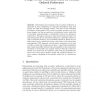920 search results - page 12 / 184 » Computing the Frequency of Partial Orders |
HEURISTICS
2006
13 years 7 months ago
2006
Representing and reasoning with an agent's preferences is important in many applications of constraints formalisms. Such preferences are often only partially ordered. One clas...
ATAL
2006
Springer
13 years 11 months ago
2006
Springer
Preferences of a single agent are often partially ordered. For example, it may be hard to compare a novel with a biography. In such a situation, the agent may want the novel and t...
SOFSEM
2009
Springer
14 years 5 days ago
2009
Springer
In this paper we define partial order semantics of types of nets. Types of nets are a parametric definition of Petri nets originally developed for a general presentation of the s...
STTT
2010
13 years 6 months ago
2010
Abstract. Runtime (dynamic) model checking is a promising verification methodology for real-world threaded software because of its many features, the prominent ones being: (i) it ...
NAA
2000
Springer
13 years 11 months ago
2000
Springer
We describe the implementation and performance of a novel fill-minimization ordering technique for sparse LU factorization with partial pivoting. The technique was proposed by Gilb...

